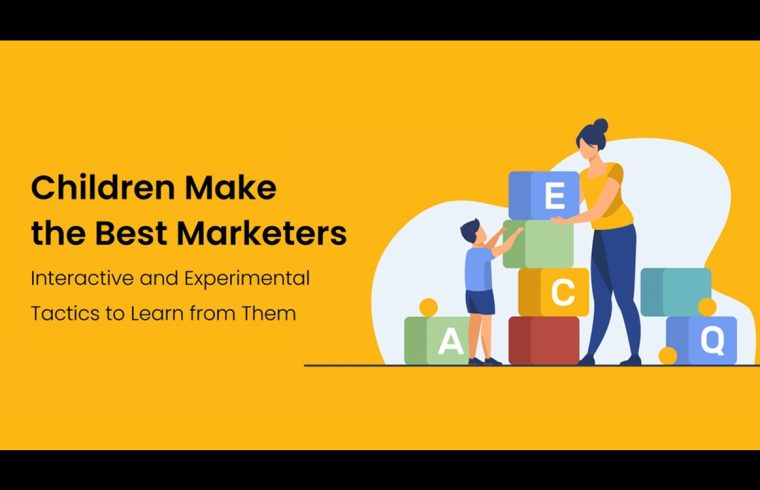I often look at children and think, ‘I wish I could be a child again!’
Of course, this thought usually stems from observing a child’s carefree nature, unbound joy, and absolute innocence, but if I think deeper, there’s so much more to being like a child. I honestly believe that if we could all be a little more like children, we could be more successful marketers.
Childhood is mostly about countless demands and getting them fulfilled requires the skills of a marketer. This is why I believe children make excellent marketers because they understand how to persuade the adults around them.
Recall the time when you aspired for your first mobile phone. Promising exceptional grades in exchange of something that parents could barely say NO to.
Who was your target back then; mom or dad?
The reality is, convincing either of the parents was never easy. But, spinning those emotional stories and taking every possible risk to pocket that phone was a very clear goal.
Right?
This is where our hidden marketer comes out.
First, convincing the customer with a story about how the product can add value to their life.
Then, taking a jump off the emotional narrative to check if it works. It’s ok if it doesn’t, at least you dared to try. Because, as kids, we don’t mind taking risks. This is where the leap of faith just pays off, whether the gamble is big or small.
As children, we all have dealt with multiple emotions; confusion, stress, frustration, anger, sadness… the list goes on. But the difference as an adult experiencing the same emotions is, how we dealt with them. As kids we handle emotions with a child-like approach to problem-solving. And that’s what I think makes all the difference!
Since the real world demands solutions, we as adults can learn much about marketing by observing children. This might help in learning the obvious lessons in identifying, finding, and being there for your target market.
Here are some marketing lessons we learnt from children:
Simplicity and transparency to avoid unnecessary chaos
Children never fail to remind us to simplify our lives—and marketing. We, as adults, overthink questions and scenarios all the time. But the thing is, kids often see the world through the most basic lens. They don’t typically overthink things. They aren’t riddled with anxiety and stress.
This reminds us not to sweat the minor stuff and that simple is often the best.
Imagine spending 30 minutes on a curt email from a client for the MARCOM strategy, then waiting hours or days for a response. Or you could ask the person in question to jump on the phone or huddle for a quick chat. This levels the playing field and limits the potential for misinterpreting signals.
Make it personal
Complex messages might be annoying. Have you seen kids learning difficult subjects? They’re bored, distracted, and won’t focus on the task at hand. Breaking a topic down into smaller chunks can help to get any information across. If your message is too complicated, it won’t reach its intended audience. On the other hand, if you imagine appealing to a six-year-old, your marketing materials are more likely to be simple and full of fun. The better you know your target, the easier it is to tell them a relevant narrative.
Storytelling is an art
Kids are predominantly swayed by feelings, not facts. Similarly, they adore stories and are susceptible to any narrative. They perceive themselves as superheroes, defeating monsters and gaining applause. Being able to envision yourself as the protagonist is vital in marketing. Tell your customers how your product or service may help them be the hero of their story. After all, who doesn’t want to slay a dragon here and there?
In marketing, identifying “the story” is worth the time.
Sometimes a brand’s story goes beyond a single product.
Short, crisp, and digestible information
Kids aren’t known for their attention span. A child’s attention span is 3 to 5 minutes per year. They like their pages short and their gratification quick; they have places to be and things to explore and are eager to move on to the next thing. In the age of smartphones, the rest of us are no better.
When creating videos, don’t make your audience wait to be engaged. Let your audience take in information in smaller chunks. Your blog posts can be long, but make them easier to absorb with bullets, subheadings, and lists. We’re now in an era where waiting for the good part of a three-minute video feels like work.
Learn, earn, and keep the resilient trust
Kids learn to ride a bike when their parents’ hands are securely around their waist. It helps them be confident that mom and dad are there to hold them—even if they speed up unexpectedly.
Aided by their caretakers’ helping hands and guidance, kids learn new things and take risks, eventually without fear. Why? Because trust has been built.
When trust is a focus in marketing, you can forge incredible bonds with colleagues, clients, customers, prospects, and partners. In a time when consumer trust is dwindling, reliance is more critical than ever.
Eat, breathe, and speak the right language
Kids learn to say their first words after hearing a lot of gibberish, strange sounds, and even different languages. Have you ever wondered how they learn to talk to their parents in their own language?
As marketers, it’s clear that we shouldn’t get too caught up in our own industry jargon and should instead speak in a way that the buyer would “instinctively” understand.
Lesson Learnt…Successful marketers intuitively know that it’s finally all about making that ‘human connect’. Maybe it’s time to shrug off the adulthood baggage and learn the best from the kids.










